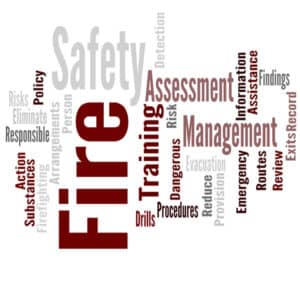- What is Staff Fire Safety Training?
Fire safety training teaches staff to recognise fire hazards, follow evacuation procedures, use firefighting equipment where appropriate, and understand their responsibilities under the Regulatory Fire Safety Order 2005.
- Is Fire Safety Training a Legal Requirement?
Yes. The Responsible Person must ensure that employees receive adequate fire safety training from the start of their employment and whenever they are exposed to new or increased risk.
- Who is the Responsible Person?
The Responsible Person is the employer or another appointed individual accountable for ensuring fire safety arrangements and for providing training.
- As a Responsible Person, What Are My Responsibilities?
You must take all reasonably practicable measures to ensure the safety of all your employees. You must also ensure the safety of any person who is not an employee while they are on your premises.
The responsible person must take “general fire precautions”; there are six main categories for this, and they must comply with all of them:
1. Reduce the risk of fires on the premises and prevent the spread of fire.
2. Have a means of escape from the premises
3. Ensure that at all times, escape routes and exits can be used
4. Have the correct firefighting equipment
5. Have a means for detecting and raising the fire alarm
6. Actions to be taken in the event of a fire, including training of staff and measures to reduce the effects of fire
You also need to consider any special requirements your business may have and implement measures to mitigate the risk of contributing to a fire, such as the use of plant machinery and the storage of hazardous materials.
The fire risk assessment is not only a necessity, but when carried out correctly, it will ensure your business meets all the criteria of the order. You can download the government fire safety guides from their website:
https://www.gov.uk/workplace-fire-safety-your-responsibilities/fire-safety-advice-documents
These documents contain all the necessary instructions to conduct an effective fire safety risk assessment.
- As the Responsible Person, Can I Deliver the Training Myself?
The Responsible Person can oversee training, but it is usually better to use a qualified trainer, especially for larger sites or where higher risks exist, because they may lack the necessary knowledge and practical experience.
- What Should Staff Fire Training Cover?
Training should be suitable and sufficient to address the risks identified by the fire risk assessment, including recognising hazards, implementing prevention measures, following evacuation procedures, identifying assembly points, using fire extinguishers if relevant, and knowing what to do in the event of a fire.
- Does Training Need to be In-person or Practical?
Training should include situational and practical exercises where appropriate; practical, hands-on experience (for example, handling an extinguisher) is recommended when the risk assessment identifies that it is necessary.
- How Often Must Training be Repeated?
This is one of the most common questions from business owners and Responsible Persons.
There is no single statutory interval, but training must be repeated where appropriate and whenever employees face new or increased risks.
Government guidance states that the frequency of fire training is based on the findings of your premises’ fire risk assessment.
Fire training should be conducted during induction and at subsequent refresher sessions at predetermined intervals.
We recommend annual refresher training and at least one fire drill per year for office and retail premises.
It is recommended that more complex or high-risk premises, such as care homes, receive training every six months.
- Will Staff Get to Use Fire Extinguishers?
Yes. Where space and safety assessments permit, the practical use of CO2 and water fire extinguishers is included in all our courses, enabling delegates to gain confidence in handling this equipment.
- Who Should Receive Extinguisher Training?
Staff nominated as fire wardens or marshals, as well as any employees expected to tackle small fires, should receive practical extinguisher training tailored to the types of fire risks on site.
- Should Training be Recorded?
Yes. Keep records of who received training, who delivered the training, the content, dates, and any drills or practical exercises. Records demonstrate compliance with the Fire Safety Order and support ongoing risk management.
- How To Make Training Effective?
We recommend a mix of formats: induction for new starters, role-specific details for fire wardens, practical exercises, and periodic refreshers. We tailor content to your premises and local risks identified in your fire risk assessment.
- What to do After Training?
Update your fire safety policy and emergency plan if needed, log training outcomes, and schedule reminders for refresher training and drills.
- Who Do I Report a Fire Safety Concern To?
The Responsible Person or your site fire warden.
- Where Are the Assembly Points?
As listed on the evacuation plan displayed in common areas.
- Do I Have to Use a Fire Extinguisher?
Only if trained and it is safe to do so; otherwise, evacuate and leave firefighting to trained staff or emergency services.
- What is the New Fire Safety Legislation?
Fire Safety regulations changed on 1 October 2006 and were subsequently updated by the Regulatory Reform (Fire Safety) Order 2005.
This new Order has streamlined and refined the way fire legislation works; in essence, it will require that ALL premises or sites to which employees or the public have access have a fire risk assessment carried out.
Fire certification will no longer be in effect, as the risk assessment will take its place. An emphasis on regular and appropriate safety training is highlighted, along with the penalties for non-compliance, which, in the worst-case scenario, could result in hefty fines and the cessation of trading.
The order categorises businesses into two main groups: those with fewer than four employees and those with more than four employees (including owners and directors).
If you have four or fewer at your place of work, you still must comply with all provisions of this order, but you are not required to have documented evidence of your risk assessment.
If you have five or more employees, you must not only comply with all the provisions of the order but also have documented evidence of your risk assessment to demonstrate compliance.
The order holds the person with overall responsibility for the premises 100% responsible for fire safety and refers to them as the “responsible person”. The responsible person is liable to heavy fines and even imprisonment if found guilty of contravening the order.
The responsible person may nominate someone else to carry out the company’s fire safety; they would be called the “competent person” This should be an employee if they are suitably qualified, but may be an external company if no one is suitably qualified.
- Is Anyone Exempt From the New Fire Safety Regulations?
Yes, a few people are exempt from this order, although that doesn’t mean they don’t have to comply with good fire safety practices; they fall under different regulations. The chosen few are:
1. Domestic premises
2. An offshore installation
3. A ship
4. Fields, woods or other land forming part of an agricultural or forestry undertaking
5. Anything with wheels
6. A borehole site
- What’s Not Covered by Insurance After a Fire?
There is a perception that the majority of the cost of a fire is insurable; however, several areas are not covered by insurance.
Financial surveys undertaken on behalf of insurance companies estimate the cost of fires to the British economy, but these statistics reflect only insured costs; many other costs are not insurable.
For every pound spent on insurance, the average non-recoverable costs were approximately 10 times the amount paid, and in some cases, up to 36 times.
Insurance premiums can be likened to the tip of an iceberg, with the majority of costs hidden below the surface.
Some of the uninsured costs are:
Product and material damage
Plant and building damage
Tool and equipment damage
Legal costs
Expenditure on emergency
Supplies
Clearing site
Production delays
Overtime working and
Temporary labour
Investigation time
Supervisors’ time diverted
Clerical effort
Fines
Loss of expertise/experience


